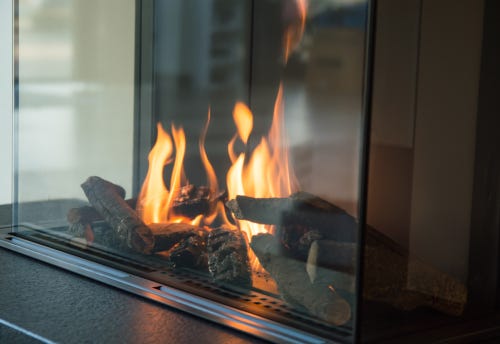Gas Log
Do you want the glow and warmth of a fireplace in your home but hate the hassle of a wood-burning fireplace? A gas log fireplace may be the right fit for you!
Gas logs bring all the benefits of more traditional options without the mess and maintenance that often comes with a real-wood fireplace. Whether you have an existing fireplace in your home or not, there is a perfect gas log fireplace for your family.
This go-to guide will help you decide the right choice for your home and teach you all there is to know about the gas fireplace market!
What are gas logs?
Gas Log Fireplaces use a stack of ceramic logs to imitate the look and feel of a wood-burning fireplace. They are an easy-to-use heating solution that comes in a variety of sizes and styles and can be fitted for almost any use.
Gas Logs vs. Gas Fireplaces
While gas logs are a type of gas fireplace, they are not as specialized in usage as the all-in-one gas fireplace system. Both gas logs and gas fireplaces require a gas line to run, but gas fireplaces run well in both built-in units and pre-existing wood-burning fireplaces.
Gas logs are much cheaper to set up, but depending on the layout of your home, a gas fireplace may be the only option for you. A gas fireplace’s box-within-a-box setup does not require an existing fireplace or chimney to install, making the placement options far greater than gas logs. Some gas fireplaces can even fit in your bedroom!
Both gas logs and gas fireplaces have multiple ventilation options, either vented or ventless, and have similar differences in heating output between them.
Gas fireplaces will also produce considerably more heat than gas logs but come at the huge disadvantage of price point. The installation of a gas fireplace can run anywhere from $2,500 to $10,000, making it a serious undertaking compared to the $200 to $1,000 range for gas logs.
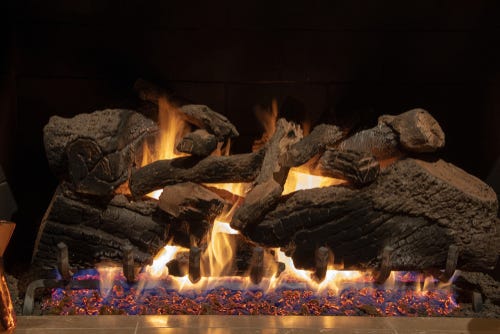

Gas Logs vs. Gas Inserts
Gas inserts act as the midpoint in price and utility between gas logs and gas fireplaces, usually costing around $3,000 to $4,000 for purchase and installation. They are a great way to step up the use of an already built-in fireplace.
Similar to gas fireplaces, gas inserts use a box-within-a-box style. The insert sits inside a metal box that is inserted into a larger box that fits the fireplace. The insert emits heat produced from the air between the two boxes.
Inserts are a more reliable source of radiant heat than gas logs, but they may be overkill for the space that you’re installing. For example, if your fireplace is in a smaller room or you live in a warmer climate, a ventless gas log system may be sufficient for your needs compared to a vented insert.
Similar to both gas logs and gas fireplaces, gas inserts come in both vented and ventless options. Vented inserts will exhaust directly through the chimney, while ventless units will exhaust into the room around them, making them an issue for smaller spaces.
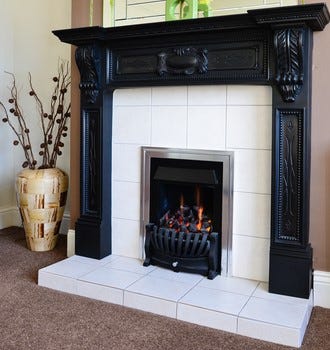

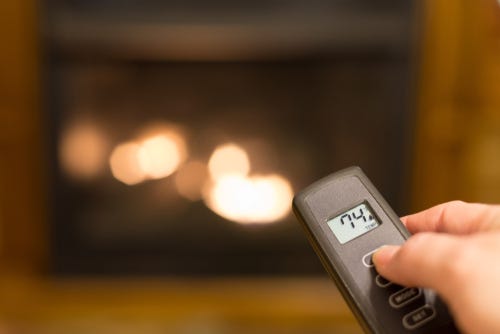

How do I pick the right gas logs?
Picking the right gas logs system for your home is not always as easy as it seems.
There is a wide variety of flame, wood, size, and quality options available alongside the standard vented and ventless categories. There’s certainly a gas log fireplace for every style or preference.
How do I measure for Gas Logs?
Sizing your fireplace can be tricky. While you may be able to fit most commercial models into your fireplace at home, it doesn’t mean that you should or that any model will look great.
For example, too small of a gas log set will be dwarfed by the fireplace itself, and too large of a set will poke out from the firebox and potentially place items around your hearth at risk.
To properly measure what gas log set you can add to your home, it is best to know three measurements: fireplace depth, internal front width, and internal back width.

Internal front width is the width measured from the front of your firebox. This will help determine how much additional space will be needed to properly window your fire.

Fireplace depth is the distance from the back of your firebox to the front of your firebox. Please do not include any additional space in this measurement, as too deep of a gas log set will never truly fit.


Internal back width is the width of the very back of your firebox. This measurement is a huge factor in determining how wide of a unit you can purchase since this is where your gas line will be hidden.
When looking for gas log sets, it is best to look at the owner’s manual for each model to see the minimum clearances. Reference these clearances with the measurements of your fireplace to find the best fit.
Additionally, it is suggested that you keep anywhere from four to six inches of space on either side of the front of your gas log set to keep it from looking too big or too small.
Trading Aesthetics for Heating Power
When it comes to the visual aspect of your gas log set, there’s a lot to consider between vented and ventless systems, but the actual heating output of your set is just as important as the aesthetics of your flame.
Vented Gas Logs
Vented gas logs are easily the best looking of the two categories, producing strong, rich flames that resemble those of a real wood-burning fire. Vents are required to exhaust the production of carbon monoxide as the fire is going.
However, the vents allow for more fuel to be used, and that brings a huge boost in visuals. The increase in fuel consumption produces deep yellow flames and vibrant red ember beds. You’ll have a hard time telling the difference between a vented system and real wood at first glance.
With the increased airflow, the issue of heat loss arises with the ventilation system. Heat rises and a large amount of the heat produced by vented systems escapes through the exhaust. While some heat will still make its way into your home, you may still have to adjust the thermostat to make serious jumps in temperature.
This also makes vented systems a great solution for families in warmer climates who are just looking for a boost in ambiance during the winter months.
So, if you’re looking for the ambiance and appearance that comes with a realistic fire, then a vented gas log system is for you!
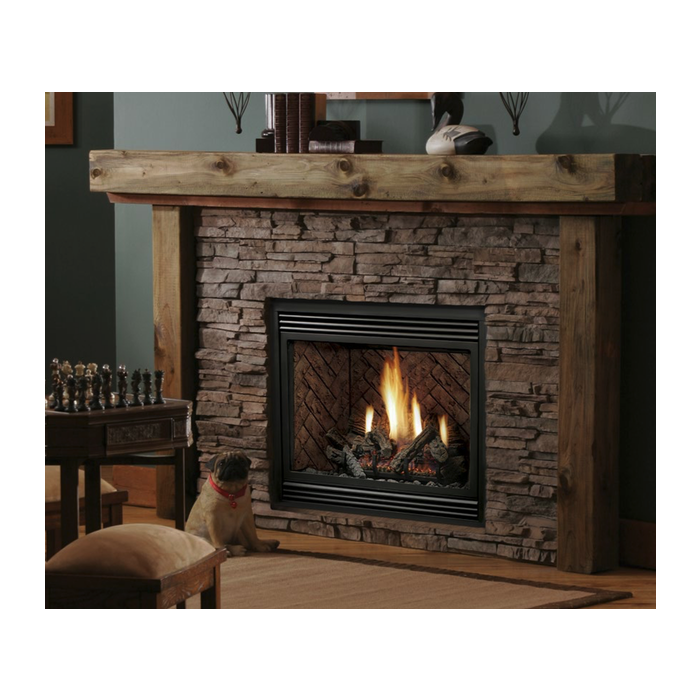

Trading Aesthetics for Heating Power
Unlike vented systems, ventless gas log sets are a very efficient way to provide some extra heat to your home. While this leaves visual appeal at a deficit, these logs still can look great in any home.
The installation of ventless systems is often much easier than vented systems as well, even though it comes with a marginal price increase. They are also more versatile to place since a firebox is not always required for installation. However, smaller installations, like bedrooms, must be below a 10,000 BTU limit to be safe to operate long term.
So whether you want to keep the bedroom a little more comfortable or you live in a colder part of the country, a ventless gas log fireplace is the perfect budget option for you!
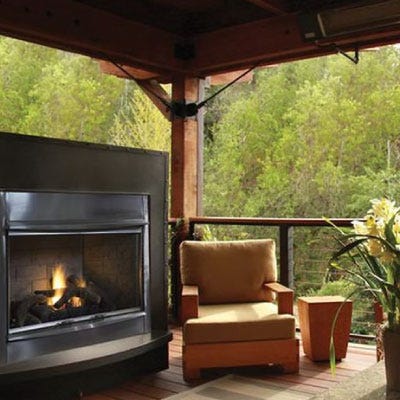

Setting Up and Caring for your Gas Logs
When your gas logs arrive, and it is time to install, there are a few things that you need to decide on beforehand. This section will help you navigate some of the most frequently asked questions and provide guidance on the best choice for your home.
How do I light my gas logs?
This has multiple answers, and it all depends on what lighting system you choose! There are three main options for lighting your fire after the gas has been turned on:
- Match Light
- Manual Safety Pilot
- Remote Control
Match Light systems are the most simple of all three and are the easiest to hide, but they require a little extra work to get going.
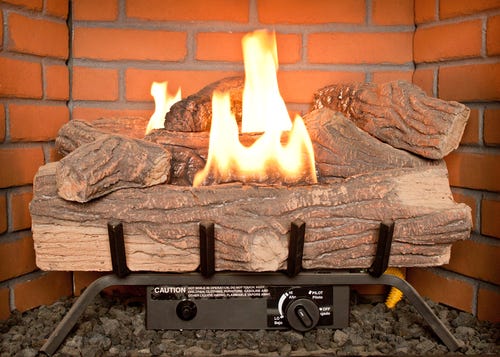

How do I light Match Light gas logs? You will have to turn on your gas key while simultaneously holding a long lighter to the gas. After the fire is lit, you can adjust it to your personal preference and enjoy your logs!
A Manual Safety Pilot is an easy-to-use alternative to the match light systems but comes at the cost of space in your firebox. This system has a safety pilot and stays lit all the time. So whenever you are ready to start your fire, all you have to do is turn on the gas and adjust the flame to your desired height.
How do I light a Pilot Light? Turn the gas off on your Manual Safety Pilot. When you are ready to light, press in the gas valve to manually feed gas into your system and turn on the sparker on your pilot light. If the pilot does not start right away, try the sparker once every second until it lights.
A Remote Control is very similar to a Manual Safety Pilot but takes up even more space on account of the receiver for the remote control. Many systems operate nearly identically to Manual Safety Pilots but have the added advantage of controlling the system from your couch.
How do I light a Remote Control System? These systems operate nearly the same as Manual Safety Pilots. Please follow the instructions for lighting a Pilot Light and refer to your owner’s manual if there are any differences.
How do I clean my gas logs?
Unlike vented systems, ventless gas log sets are a very efficient way to provide some extra heat to your home. While this leaves visual appeal at a deficit, these logs still can look great in any home.
The installation of ventless systems is often much easier than vented systems as well, even though it comes with a marginal price increase. They are also more versatile to place since a firebox is not always required for installation. However, smaller installations, like bedrooms, must be below a 10,000 BTU limit to be safe to operate long term.
So whether you want to keep the bedroom a little more comfortable or you live in a colder part of the country, a ventless gas log fireplace is the perfect budget option for you!
